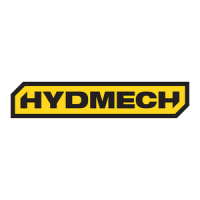10--4
119
Use and maintenance manual S20DSP
SOLUTIONPROBABLE CAUSEPROBLEM
Broken teeth
' Cutting pressure too high .Check and set to correct
pressure
' Tooth pitch unsuitable .Teeth too close together:
change blade for one with a
coarse r tooth pitch
' Swarf welded to teeth and
gullets
.Check blade --cleaning cool-
ant jets. Check the blade--
cleaning brush. If the swarf is
not removed from the blade it
will be drawn back into the
cut and weld to the teeth,
causing tooth breakage
' Swarf welded to teeth and
gullets
.Check blade --cleaning fluid
jets. Check blade-- cleaning
brush. If the swarf is not re-
moved from the blade it will
be drawn back into the cut
and weld to the teeth, caus-
ing the teeth to break.
' Material defects .The material may have al-
tered surface areas, such as
oxides or sand, or subcooled
inclusions in the section.
These areas are much
harder than the blade and
will cause the teeth to break:
scrap or clean these ma-
terials.
' Workpiece not clamped .The blade may break if the
workpiece moves during cut-
ting: check the vice, jaws and
clamping pressure
' The blade stops in the cut .Cutting pressure too high:
check and restore to rated
pressu re. Downstroke speed
too fast: reduce speed. Cut-
ting speed too slow: in-
crease. The blade slips on
the flywheels: either the
wheels are worn and need to
be replaced or the blade ten-
sion is incorrect (too low) and
must be re--adjusted.
' New blade inserted in a par-
tially made cut
.The cutting surface may
have been subjected to a lo-
calised heat--induced alter-
ation, making it harder: re-
commence cut using a
slower cutting and down-
stroke speed. A tooth from
the old blade may be left in
the cut: check and remove
before restarting work.

